The Whyte E-180 RS v3 sits at the top of the brand’s electric mountain bike range in all metrics including price, spec and travel. The E-180 v3 runs on 27.5in wheels front and rear and has 170mm of rear-wheel travel that’s matched with a 180mm-travel fork.
This RS version features Fox’s Factory 38 and X2 dampers, DT Swiss HX 1700 wheels with 350 hubs and a SRAM X01/GX Eagle drivetrain. Except the grips, there isn’t a single house-brand product fitted to the E-180 RS.
The downhill focus of the E-180 is undeniable, but its motor should help make it a bit more of an all-rounder than its spec would indicate.
Providing the assistance is Bosch’s Performance Line CX motor with 85Nm of peak torque and up to 250w of assistance. It’s powered by Bosch’s 625Wh battery, installed in the bike’s down tube. Motor control is taken care of by the Purion display.
Whyte E-180 RS v3 frame and suspension details
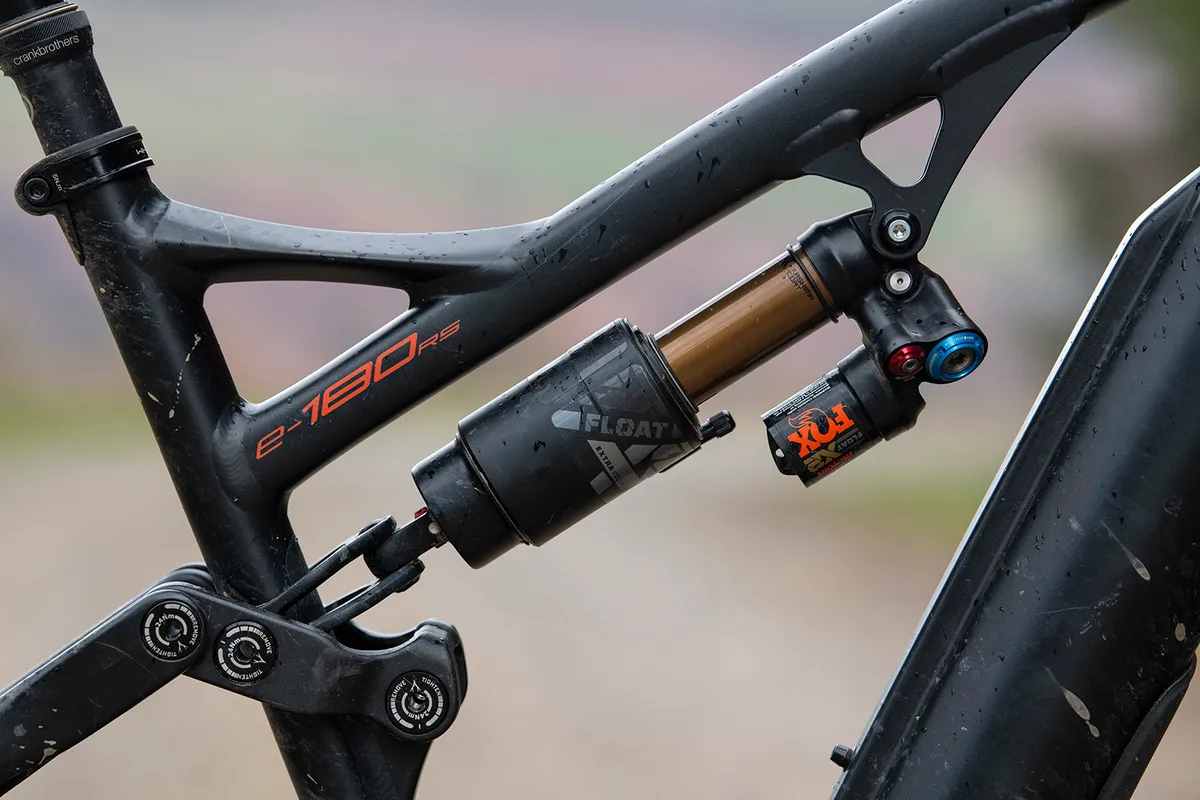
Whyte claims its “radical frame design” helps make the weight of the motor and battery enhance handling and performance by designing it so both components are as low down as possible.
This has been achieved by rotating the motor upwards in the frame so the battery can overlap it at the front. Traditionally, electric bike batteries sit above the motor rather than in front of it. Add in 27.5in wheels and it’s clear Whyte is gunning for the lowest centre of gravity possible.
The 6061 T6 aluminium tubes have been hydroformed and are multi-butted to improve strength in crucial areas, while saving weight elsewhere. It has internally routed cables through the front triangle and along the chainstays, and there’s a water bottle mount beneath the rear shock on the down tube.
The driveside chainstay features in-built chain slap protection, and there’s rock-strike protection on the underside of the down tube.
Suspension kinematics
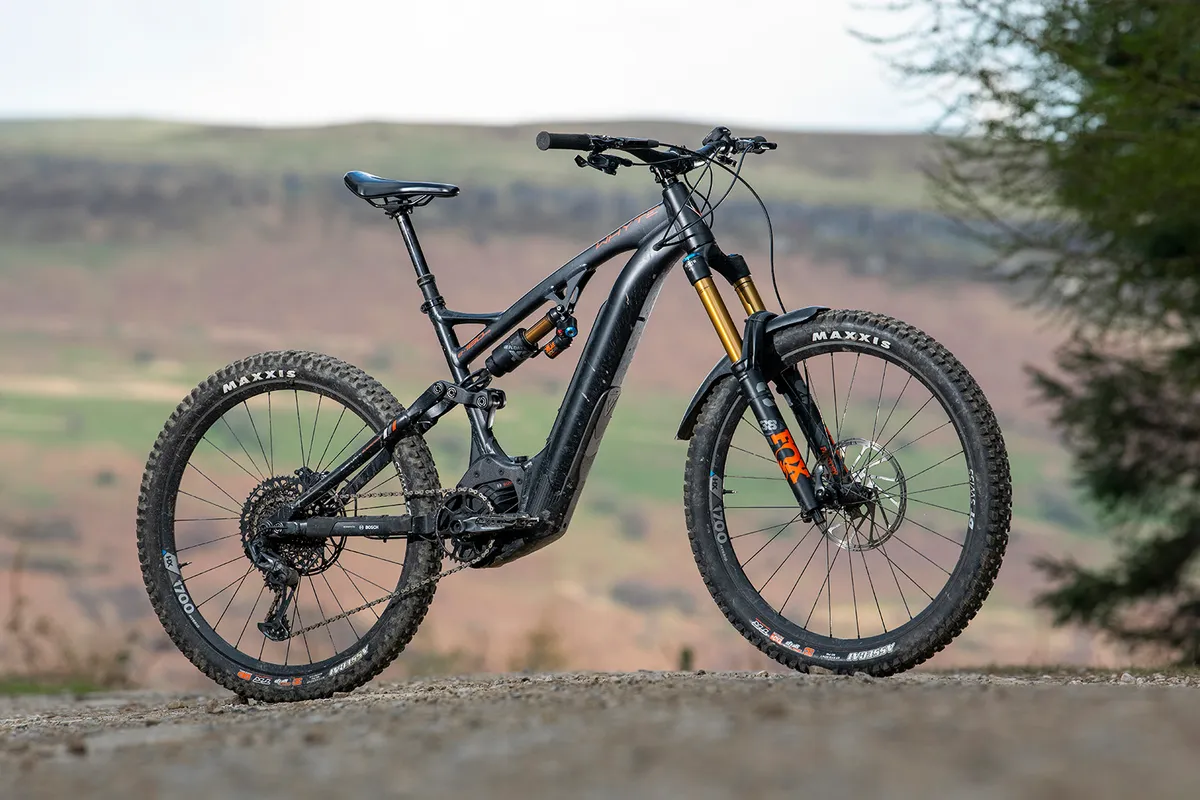
The E-180’s 170mm of rear-wheel travel is controlled by a Horst-link suspension design, where the rear wheel is mounted to the seatstay behind the chain- and seatstay pivot. Whyte claims the suspension is “slam happy”, which can be taken to mean it has plenty of progression with a good mid-stroke platform and lots of bottom-out resistance.
These claims are true according to Linkage Design, where the E-180 is shown to be 27.69 per cent progressive throughout its travel. Although this isn’t as progressive as bikes such as the YT Decoy, it is still a high figure.
When mated with a volume-adjustable air shock – such as the X2 fitted here – progression can be increased further should a rider desire.
Anti-squat at sag is around 84 per cent, making the suspension more likely to bob when the bike is pedalled.
Anit-rise figures are very low, sitting between just under 62 per cent at full travel and just over 50 per cent at bottom-out. Its suspension should remain more supple on the brakes, because the braking forces will extend rather than compress it.
Whyte E-180 RS v3 battery and motor
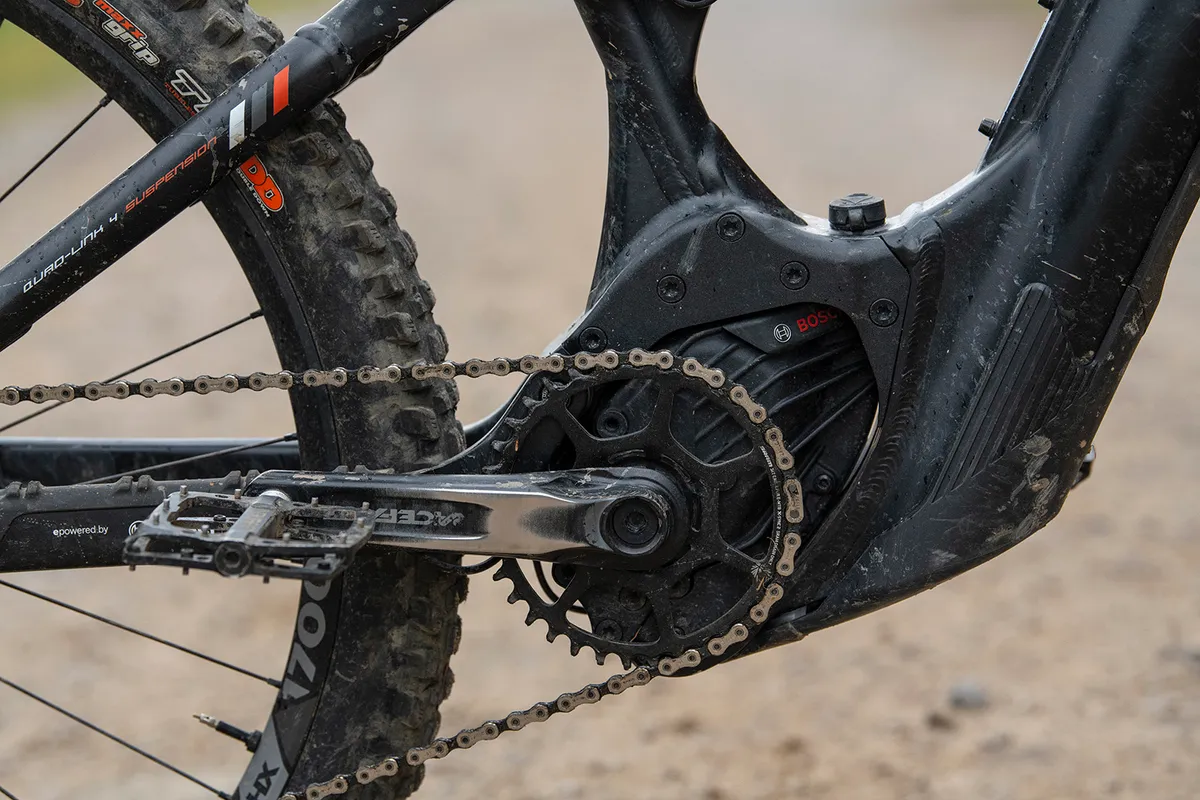
Bosch’s Performance Line CX motor has up to 85Nm of torque and 250w of assistance, rivalling Shimano’s EP8. The E-180 RS is fitted with Bosch’s PowerTube 625 battery, which has a 625Wh capacity, once again closely rivalling Shimano’s system.
Bosch’s backlit Purion display provides rudimentary data and features the mode selector buttons, but doesn’t have any form of smart connectivity.
It’s not possible to pair the E-180 RS to Bosch’s ebike smartphone apps to tune motor outputs in any given mode, something that is possible with their other ebike controllers, such as the Kiox 300.
The E-180 RS is limited to the standard four riding modes: Eco, Tour, eMTB and Turbo. There’s also a walk function.
Whyte E-180 RS v3 geometry
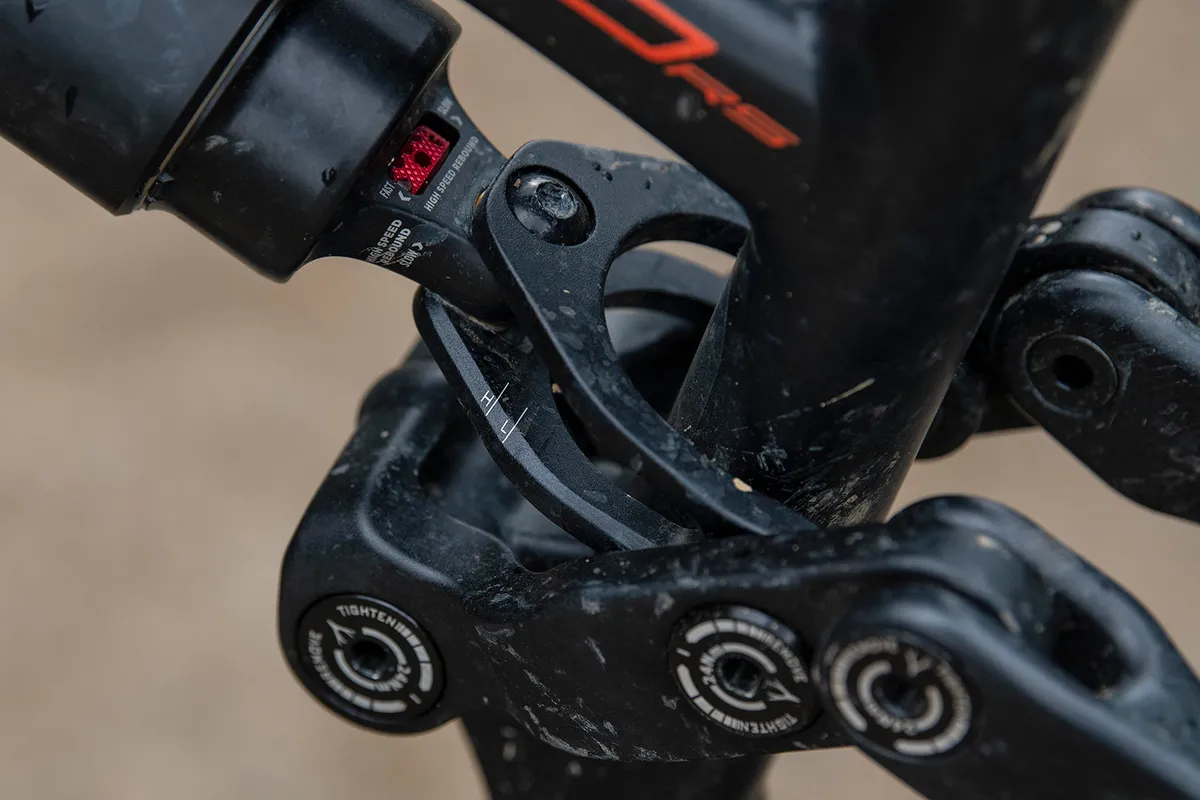
I tested the large E-180 RS that has a 480mm reach, making it spot-on for my 178cm height and riding style. There is a geometry adjustment shock bushing Whyte calls the ‘Shape.it Link’, that can be rotated to switch between high and low settings.
According to Whyte’s figures, the chainstays are 442mm long, while the wheelbase sits at a lengthy 1,270mm. In the high setting, the head tube angle is 64 degrees, but this slackens to 63 degrees in low.
In high, the bottom bracket height is 341mm (measured) and 331mm (measured, low). The seat tube angle sits around 75 degrees in both settings. The seat tube is 457.2mm long but is straight, so there’s plenty of dropper insertion depth.
These figures clearly indicate the Whyte’s go-fast, be-stable intent, and even in the high setting is slacker and lower than quite a few other bikes in this category.
It’s impossible to criticise any of the E-180’s geometry figures because it melds modern numbers without pushing the boundaries too far.
| | M | L | XL |
|---|---|---|---|
| Seat angle (degrees) | 75.5 | 75.3 | 75.1 |
| Head angle (degrees) | 64 | 64 | 64 |
| Chainstay (mm) | 444 | 444 | 444 |
| Seat tube (mm) | 431.8 | 457.2 | 482.5 |
| Head tube (mm) | 120 | 130 | 145 |
| Bottom bracket height (mm) | 335 | 335 | 335 |
| Wheelbase (mm) | 1,241 | 1,270 | 1,302 |
| Standover (mm) | 841 | 841 | 841 |
| Stack (mm) | 626.3 | 635.2 | 648.7 |
| Reach (mm) | 455 | 480 | 505 |
Whyte E-180 RS v3 specifications
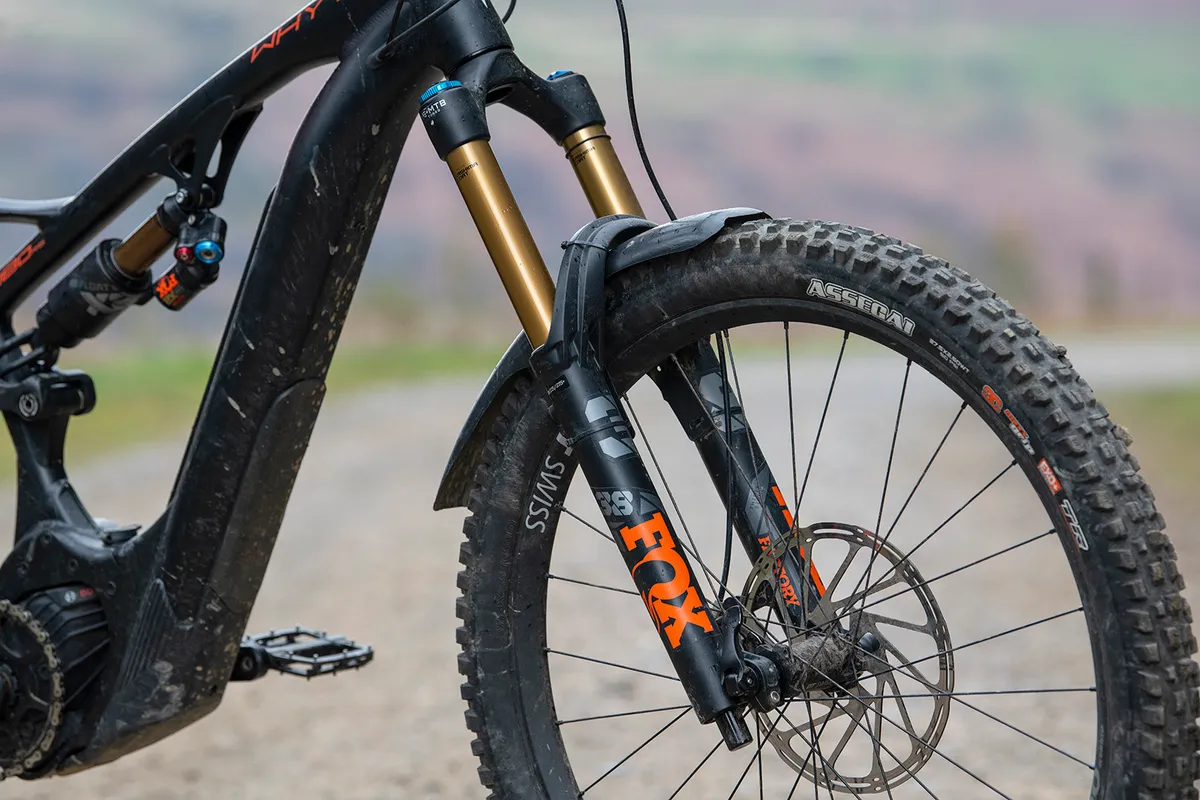
Fox’s 180mm-travel 38 Factory fork sits at the front of the E-180 and is matched with a Fox Float X2 Factory shock. It rolls on DT Swiss’s H 1700 wheels that use 350 hubs with the Ratchet System freewheel.
These are wrapped in a Maxxis Assegai EXO+ casing MaxxGrip front tyre and an Assegai DoubleDown casing MaxxGrip rear.
Elsewhere, there’s a SRAM X01 derailleur and single-click ebike X01 shifter, and SRAM’s Code RSC brakes with a 220mm front rotor and 200mm rear.

It has a Race Face Turbine R bar and Atlas stem, and runs a Crankbrothers Highline 3 dropper post with 150mm of travel. Finally, it’s fitted with Fizik’s Terra Aidon ebike saddle.
Without pedals, my large test bike weighed 25.78kg.
Whyte E-180 RS v3 ride impressions
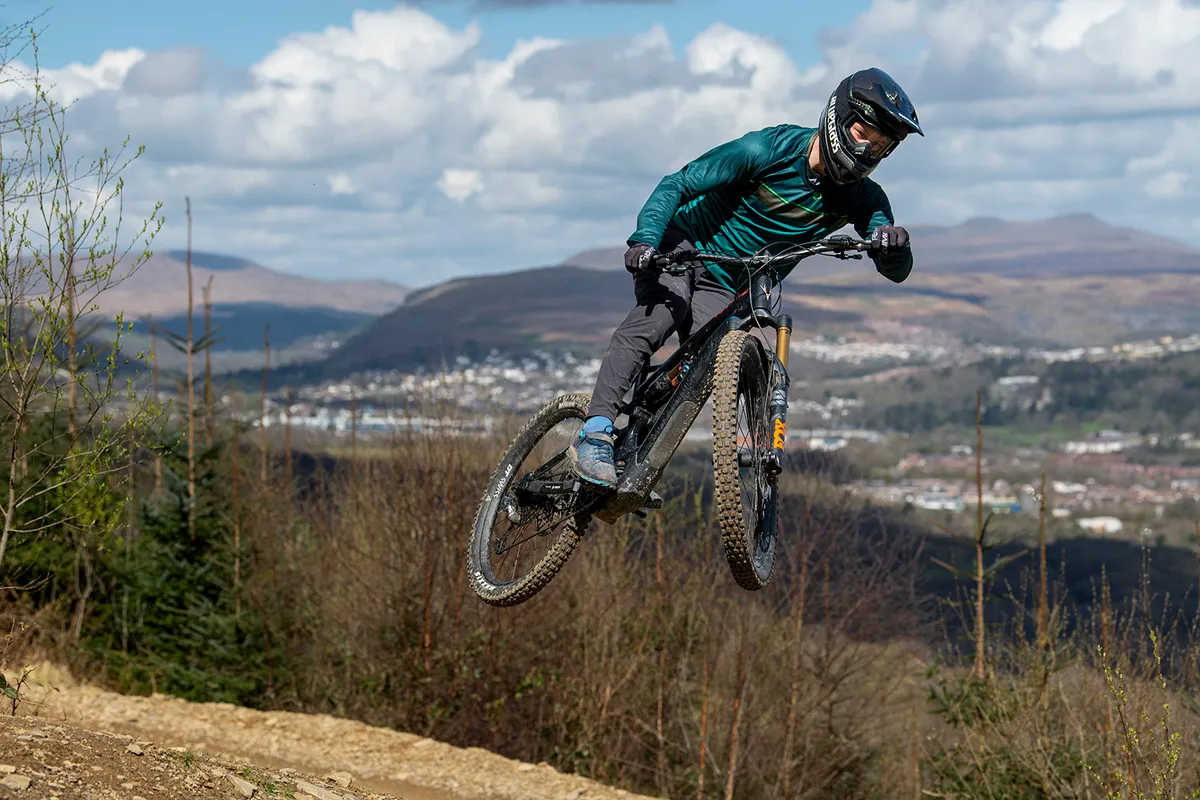
I put the Whyte through its paces on the same terrain and trails used for the UK’s round of the Enduro World Series, making the test ground worthy of its long-travel suspension.
Conditions ranged from disgustingly wet through to dusty dry, with every type of weather in between.
Whyte E-180 RS v3 setup
Whyte doesn’t offer a setup guide on its website for the E-180, but thanks to its Fox suspension, getting it feeling good was relatively simple.
I installed three volume-reducer spacers in the fork’s air spring and inflated it to 98psi, giving 39mm or 21 per cent sag. I set all the compression and rebound adjusters to fully open.
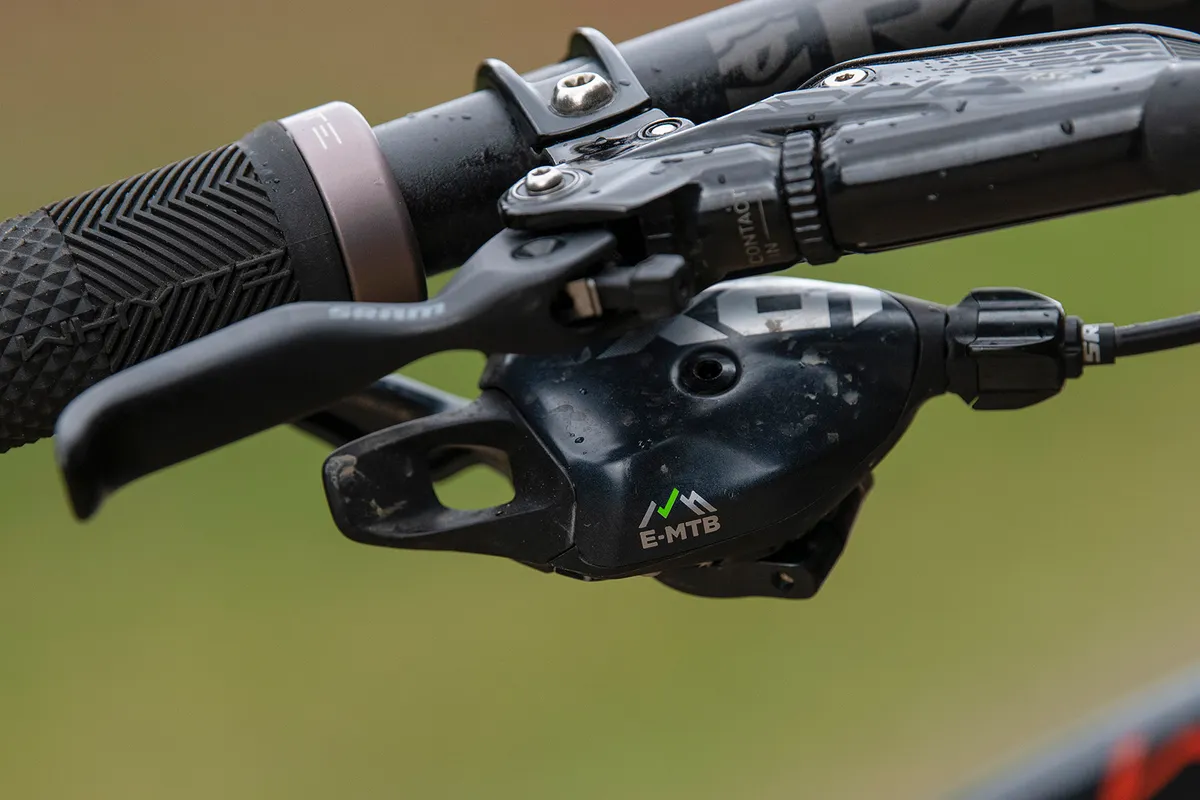
I inflated the shock to 190psi. This gave the bike 19mm, or 29 per cent sag, and thanks to its progressive leverage rate, I didn’t add any volume-reducer spacers.
Although I started testing with the compression and rebound adjustment set to fully open, I increased low-speed compression by +4 clicks from fully open during the test period.
I initially set the bike to its low-geometry setting, giving a 63-degree head angle and 331mm bottom bracket height. However, once I had tried it in the high setting, where the head angle was 64 degrees and bottom bracket height 341mm, I much preferred it, and left it there for the remainder of the test period.
Although I set tyre pressures according to the trail conditions, the front and rear DoubleDown casing 3C MaxxGrip compound tyres meant I could run lower pressures compared to bikes with thinner casings or harder-compound rubber.
Whyte E-180 RS v3 climbing performance
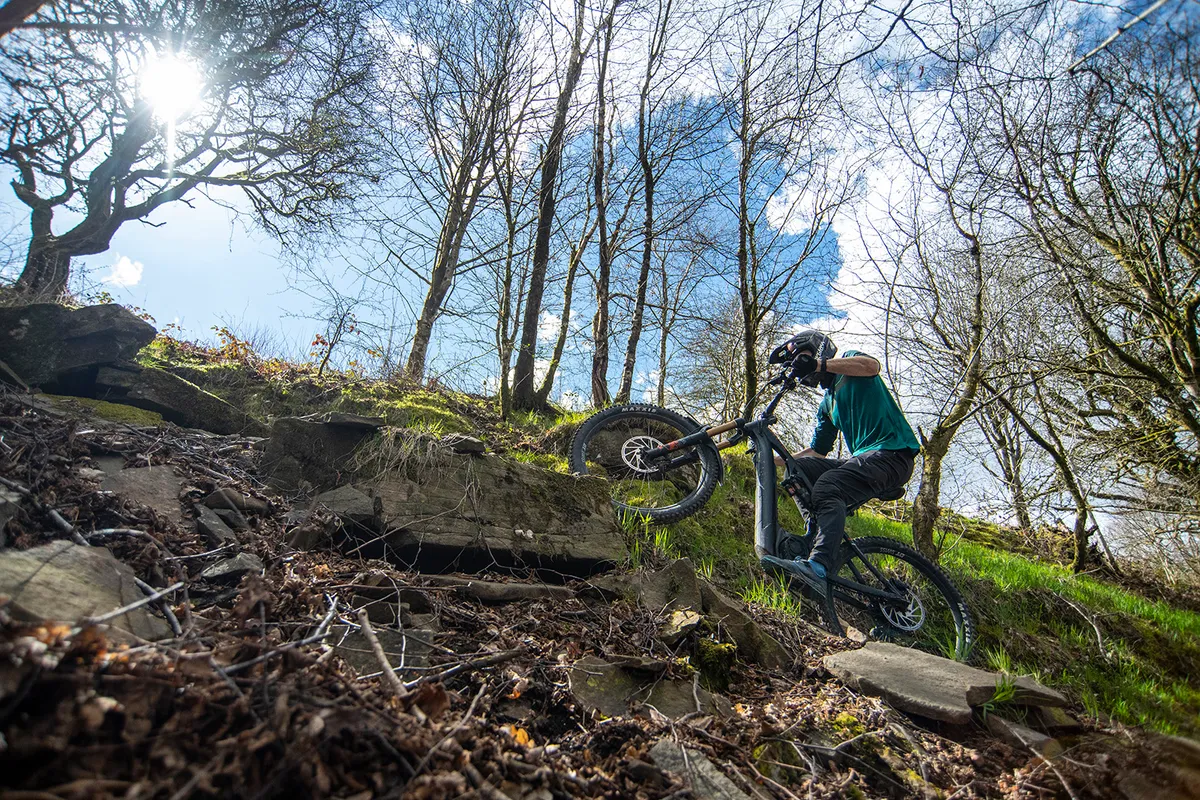
The Whyte’s middle-of-the-road 75-degree seat tube angle meant I ended up adjusting the saddle nose down and pushing it as far forward as possible in the seatpost clamp. This helped reduce the feeling of my hips being rearward of the bottom bracket, giving the E-180 a reasonably neutral climbing position.
My weight was spread evenly between the front and back wheels, which not only helped improve grip on the climbs, but also reduced wheelspin and front-wheel lift usually created by a front-to-back weight imbalance.
To boot, most of my body’s weight was concentrated through the saddle rather than into my hands, thanks to its upright seated riding position.
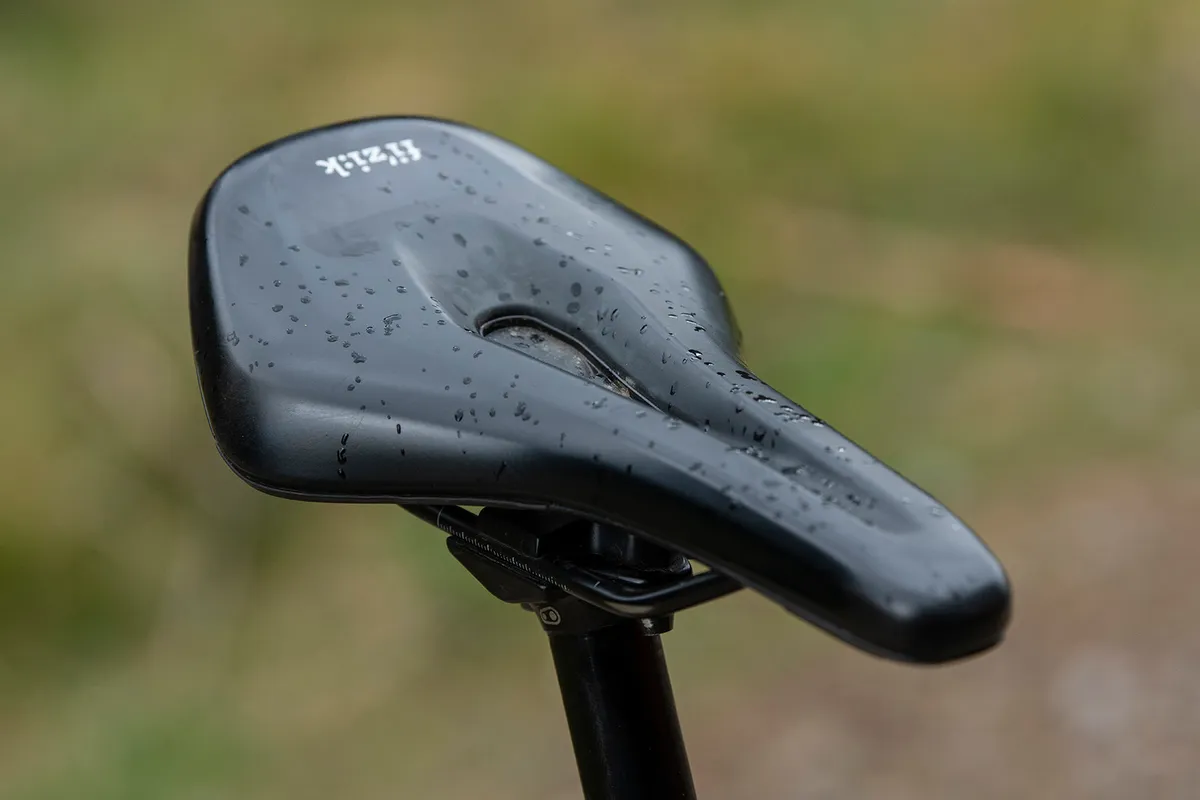
This helped reduce fatigue on longer fire-road shuttles because I was less aggressively leant forward over the bars, but it also helped on steeper, more technical climbs because the neutral position meant I could quickly and efficiently weight the front or rear wheel without destabilising the chassis.
The level of calmness created by the bike’s geometry is bolstered by the suspension’s smooth, fluttery and plush action. It not only absorbed chatter on worn trail-centre surfaces well, but also helped provide grip on slippy root-infested or rock-strewn ascents, where the rear wheel was in constant contact with the trail’s surface.
The progressive support of the rear suspension’s kinematics helped stop the bike from using up too much travel through medium-size compressions, but also kept the seat tube angle from slackening via excessive suspension compression on very steep inclines with my weight pivoted onto the rear wheel.
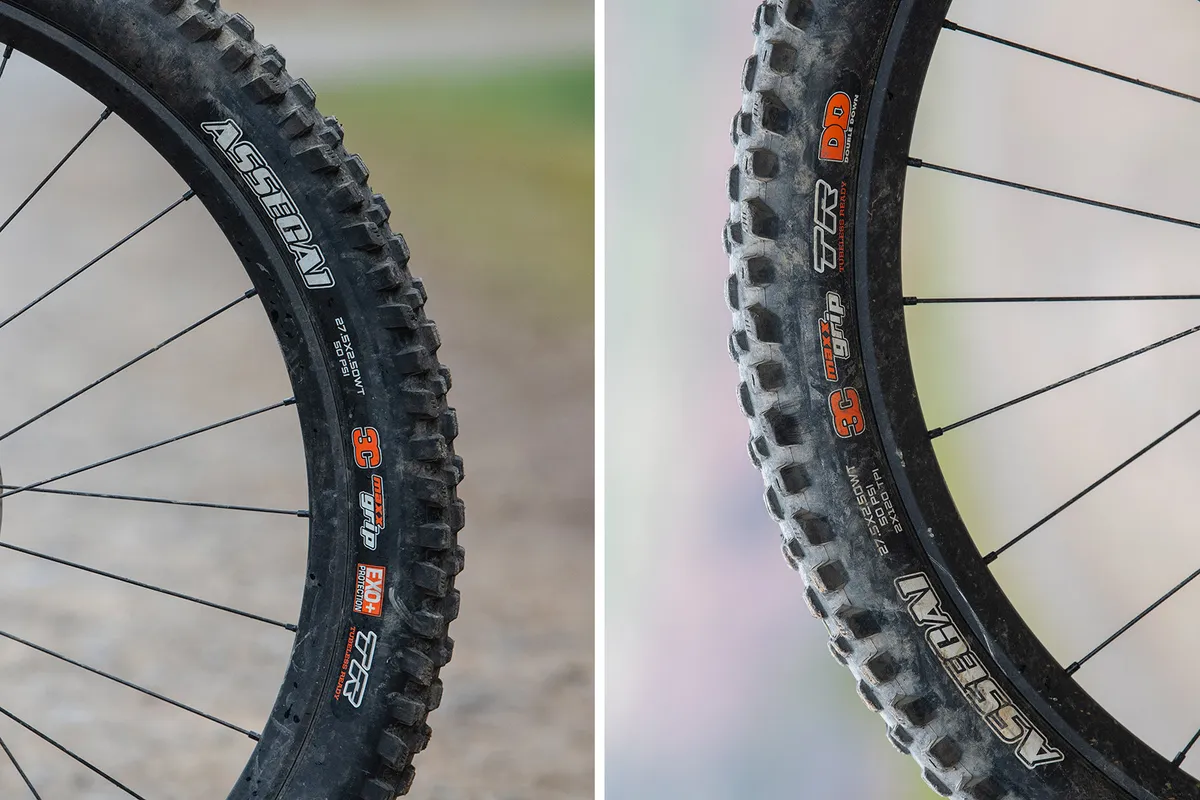
The impressively grippy Maxxis Assegai MaxxGrip compound tyres did a commendable job both of providing excellent chemical grip on slick terrain, but also digging into softer dirt to reduce wheelspin.
For a downhill-focused front tyre, the Assegai is a true performer at either end of the bike.
Battery life
Thanks to the 625Wh battery, in eco mode it was possible to eke out more than 2,300 metres of climbing on a single charge. This was impressive given the sticky Maxxis rubber and high 25.78kg weight figure, and goes to show that in its lowest setting, the Bosch motor is truly frugal.
However, increase the assistance levels to trail, eMTB or turbo and battery life was reduced, especially in the top two modes. In eMTB and Turbo modes, 1,200 metres of ascent was just about possible.

However, in those modes, the power the Bosch offers is addictive, constant and almost perfectly mirrors rider inputs, where it doesn’t have a glass ceiling of support; the harder you pedal, the more the motor gives back.
Arguably, the Bosch is the most powerful-feeling motor currently on sale. The Whyte’s winch-and-plummet attitude, where the time spent riding to the top of the hill isn’t a priority and is best executed as quickly as possible, using the smallest amount of energy, is well suited to the Bosch’s feel.
Whyte E-180 RS v3 descending performance
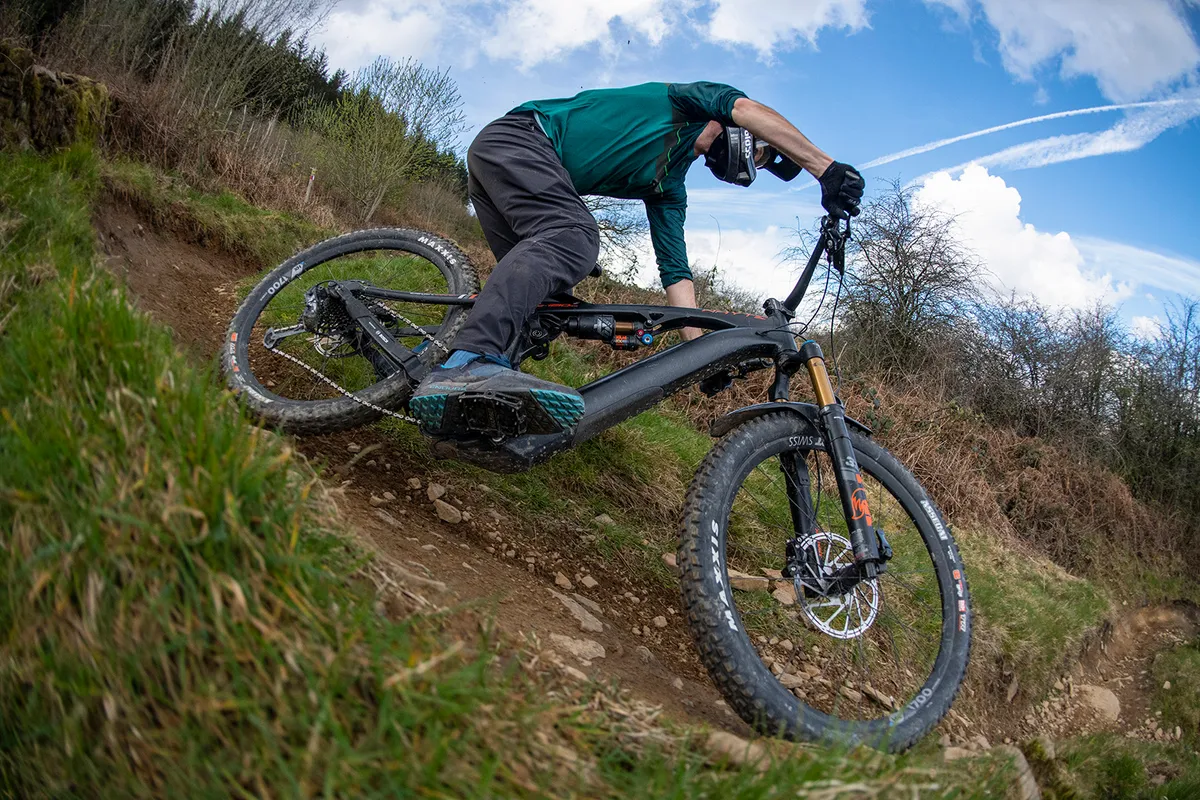
The Whyte is an absolute monster on the descents. Its weight, suspension, geometry and spec combine for a near-perfect performance, with the bike arguably feeling its best when charging on gnarly terrain
Despite the 27.5in wheels front and rear, the Whyte is seriously stable over rough ground, its long wheelbase and slack head tube angle helping to keep its chassis more level with the horizon than a shorter bike. This means less rider input is needed to keep it tracking a specific line, where undulations don’t upset any of its composure.
However, in the low-geometry setting, the Whyte was a bit of a handful to ride unless I was totally committed to my chosen line.
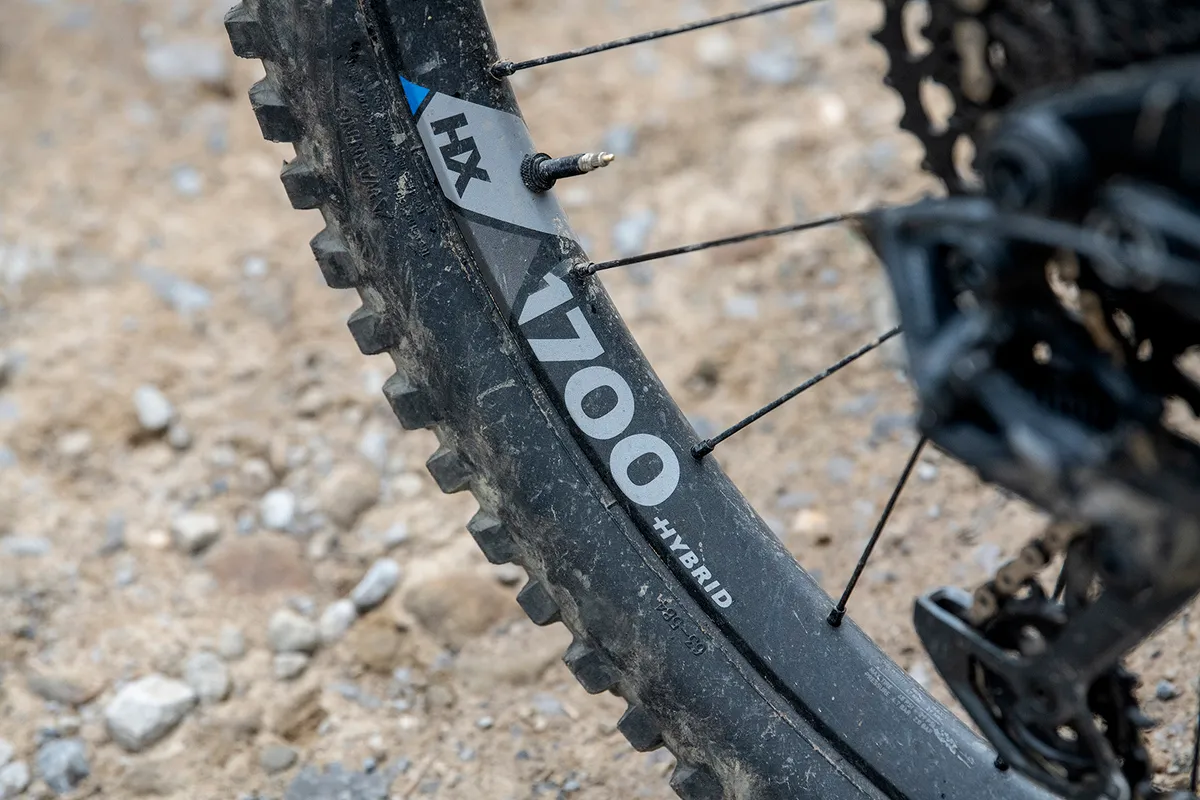
Thanks to the weight figure and slack geometry combining, if I was cruising or not confidently weighting the front wheel, it tended to run away from me when I wanted to change lines quickly or tackle sharper turns. In this setting, the proactive riding style it needed would better suit more confident or experienced riders.
Set to the high-geometry position, however, it came alive in tighter turns and slower trails, with its weight still helping to maintain that high-speed, gnarly terrain stability. Bringing the front wheel closer to the bottom bracket meant getting weight over it was easier and required much less commitment.
In the high setting, it was agile and nimble with deliberate changes in rider weight having an equal effect on the bike’s direction.
This blend of stability and agility was amplified by the long-travel, supportive and massively supple suspension. Small bumps were ironed out with total control thanks to the sprung-to-unsprung weight ratio creating impressive sensitivity and suiting the Fox dampers’ stock tunes well.
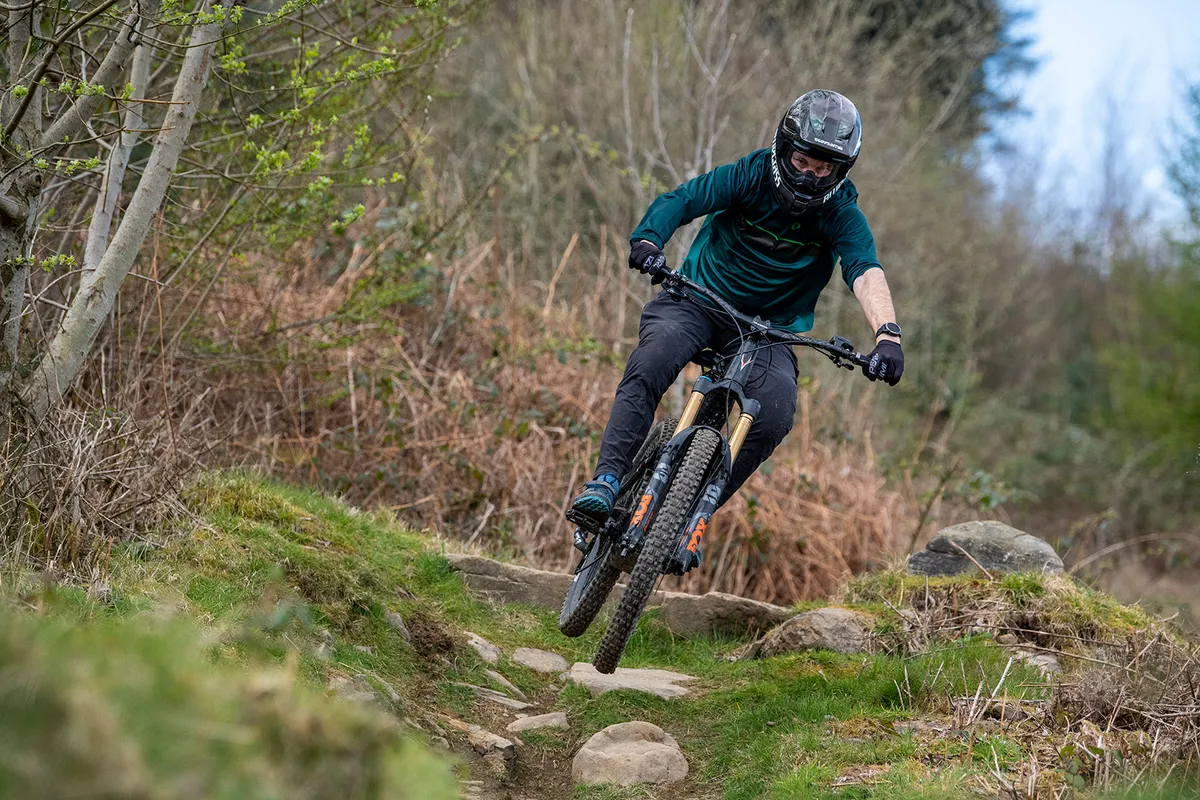
Deeper into the travel, there was plenty of support to push against in turns or through compressions. That support could also be used to drive the bike into and then off the ground to help change direction by going light, making the Whyte ride like a bike that weighed a few kilograms less.
Towards bottom-out, there’s enough ramp-up to reduce harshness, and the Fox fork is well suited to the rear end’s natural progression.
Entering corners felt incredibly natural. The bike was eager to lean over and stick to the ground, with immense grip created by the weight, suspension and tacky-compound Assegai tyres.
It had an element of softness to its ride quality, too. Banging though and over rough terrain wasn’t a teeth-rattling harsh experience. Instead, the Whyte felt smooth and muted, and bumps were perceptible without creating fatigue. I didn’t have to grip the bars tightly to maintain control, either.
How does the Whyte E-180 RS v3 compare?
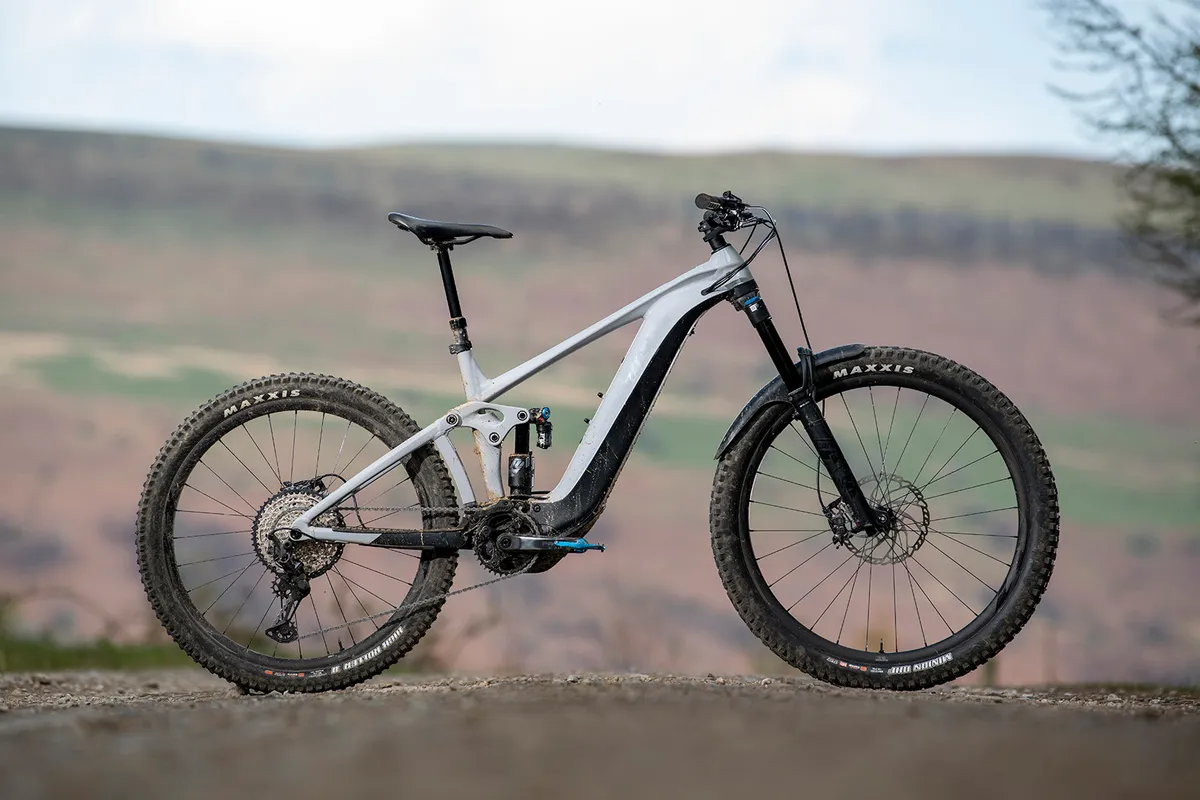
The Whyte’s weight and geometry figures are very close to the Giant Reign E+ 1, and it would be reasonable to expect a similar ride quality from both bikes.
This couldn’t be further from the truth, with the Whyte trumping the Giant in every metric bar stiffness, and that’s a good thing. What sets the two bikes apart is the Whyte’s smoother-feeling ride.
It doesn’t reverberate bumps or harshness into the rider, reducing fatigue and improving fun and control.
Compared to the Nukeproof Megawatt, the Whyte is a different beast entirely. Although both bikes have a descending bias and an EWS racing pedigree, the Nukeproof is more fun, more playful and easier to ride fast, but the Whyte is a faster bike and is way more stable.
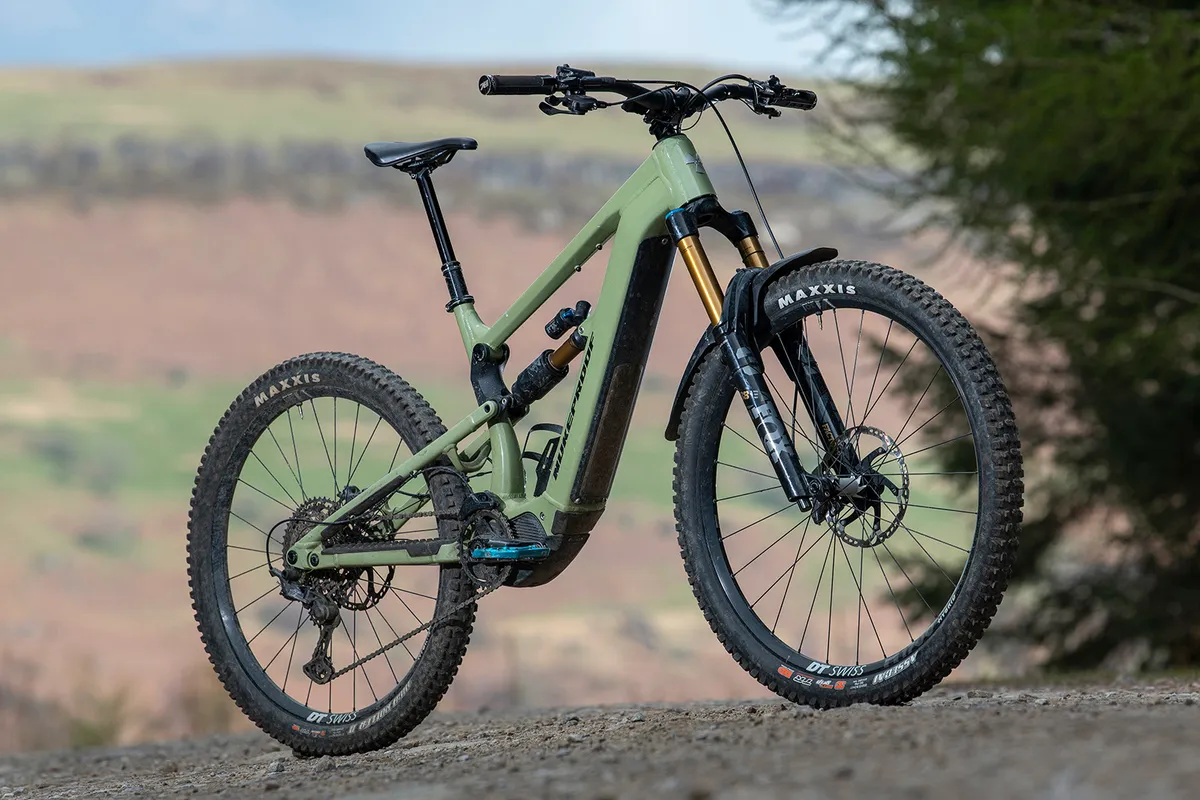
In terms of motors, the Whyte’s Bosch is massively powerful and its assistance in eMTB and turbo modes complements a rider’s inputs perfectly.
In eco, it can be just as frugal as an EP8, but the Shimano is more balanced across its assistance modes, especially in terms of battery efficiency.
Picking an outright winner between these two bikes is nigh-on impossible, for while they are just as capable on the same terrain, they ride so differently that each will suit a specific type of rider better than the other.
Whyte E-180 RS v3 bottom line
The Whyte E-180 RS v3 is a hard-charging monster truck suited to outright speed on the gnarliest descents.
Although it’s more than capable of shuttling a rider back to the trail head, regardless of the type of terrain you’re scaling, it’s at its best on the descents.
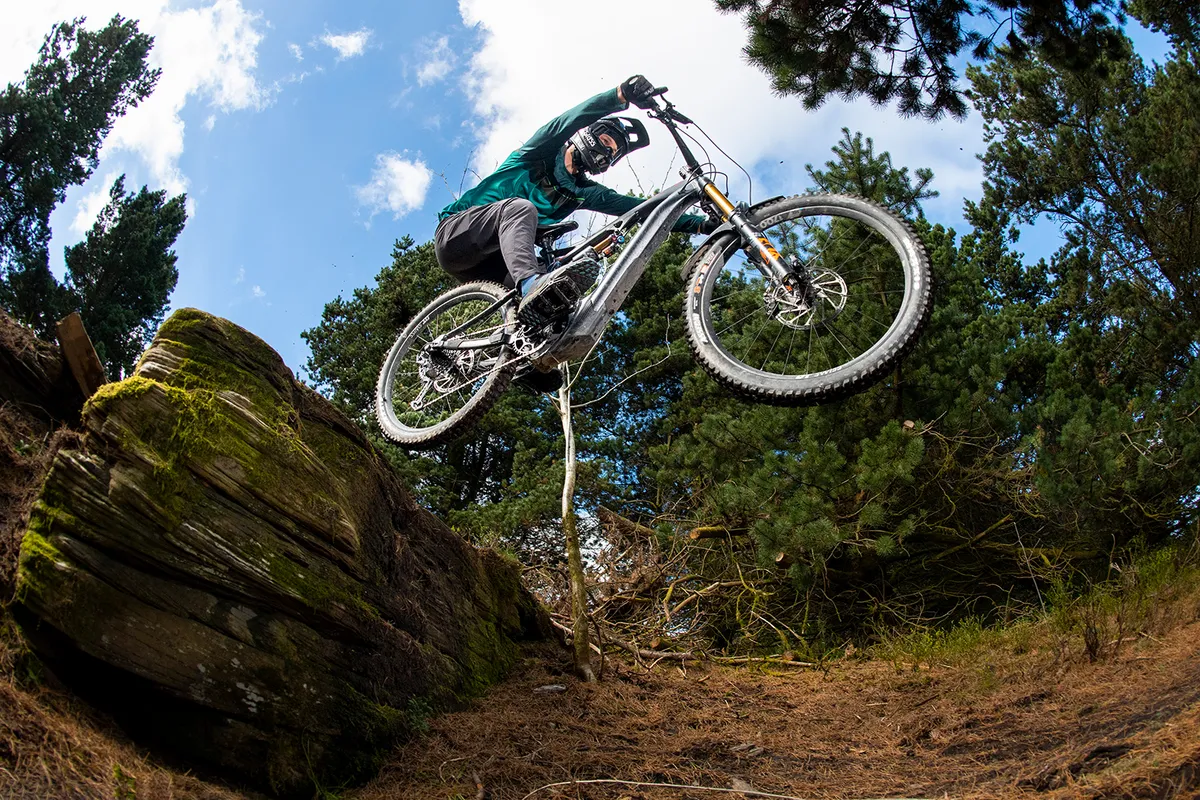
Its weight, geometry, suspension and damped feel combine to create a beautifully composed and massively natural bike to ride, especially when you’re reaching your limits.
Its long-travel racing pedigree rewards commitment best, however, and if speed is your thing, you won’t be disappointed by the E-180.
How we tested
Despite this being the inaugural edition of eMTB Bike of the Year test, we’ve had plenty of experience testing ebikes to their absolute limits. That means finding out which of these eight bikes is the best electric mountain bike currently on sale was made a little easier.
Although that’s not to say our job was simple, and choosing a winner came down to the wire, where the second and first place bikes swapped positions more times than we checked our tyre and shock pressures.
The majority of the ebike testing happened in Scotland’s Tweed Valley, home to the legendary Glentress trail centre, Golfie enduro tracks and Innerleithen downhill runs. The terrain we tested the bikes on, therefore, was wide in scope and representative of what a modern enduro bike should be able to handle, whether that was gravity-fuelled laps on the DH tracks, epic enduro missions with long descents or gruelling trail rides with hours in the saddle.
To win this year’s test, we were looking for a bike that offered the best all-round package with fewest compromises and was able to perform on every type of riding we could throw at it. In an ode to a bike tester’s cliché, it had to descend like a downhill bike, pedal and climb like a cross-country bike and be as comfortable to ride as an enduro bike.
Our 2022 eMTB Bike of the Year contenders are:
Product
| Brand | whyte |
| Price | 7699.00 GBP |
| Weight | 25.5800, KILOGRAM (L) - without pedals |
Features
| Fork | Fox 38 Factory GRIP2 EVOL, 180mm (7in) travel |
| br_stem | Race Face Atlas, 35mm |
| br_chain | SRAM GX Eagle |
| br_frame | 6061 Alloy, 170mm (6.7in) travel |
| br_motor | Bosch Performance Line CX/Bosch PowerTube 625Wh/Bosch Purion |
| Tyres | Maxxis Assegai 3C Maxx Grip EXO+ TR WT 27.5x2.5in (f), Maxxis Assegai 3C Maxx Grip DoubleDown TR WT 27.5x2.5in (r) |
| br_brakes | SRAM Code RSC, 220/200mm rotors |
| br_cranks | Race Face Aeffect e-bike, 36t |
| br_saddle | Fizik Terra Aidon |
| br_wheels | DT Swiss HX 1700 |
| br_shifter | SRAM X01 Eagle Single Click |
| br_cassette | SRAM XG-1275, 10-52t |
| br_seatpost | Crankbrothers Highline 3 (dropper) |
| br_gripsTape | Whyte Lock-on Enduro |
| br_handlebar | Race Face Turbine R, 800mm |
| br_rearShock | Fox Float X2 Factory |
| br_availableSizes | M, L, XL |
| br_rearDerailleur | SRAM X01 Eagle (1x12) |
